 |
| इयत्ता दहावी इतिहास धडा इतिहासलेखन भारतीय परंपरा मराठी स्वाध्याय PDF |
या लेखात, आम्ही इतिहास धडा इतिहासलेखन भारतीय परंपरा विषयासाठी इयत्ता दहावी मराठी सोल्यूशन्स देऊ. इयत्ता दहावी मधील विद्यार्थी पाठ्यपुस्तकांमध्ये उपस्थित असलेल्या व्यायामांसाठी प्रश्न आणि उत्तरे डाउनलोड आणि कॉपी करण्यास सक्षम असतील.
इयत्ता दहावी इतिहास धडा इतिहासलेखन भारतीय परंपरााच्या पुस्तकात महाराष्ट्र बोर्डाच्या अभ्यासक्रमातील सर्व प्रश्नांचा समावेश आहे. येथे सर्व प्रश्न पूर्ण स्पष्टीकरणासह सोडवले आहेत आणि डाउनलोड करण्यासाठी विनामूल्य उपलब्ध आहेत. महाराष्ट्र बोर्ड इयत्ता दहावी इतिहास धडा इतिहासलेखन भारतीय परंपरााचे पुस्तक खाली दिले आहे. आम्हाला आशा आहे की आमच्या इयत्ता दहावी वीच्या इतिहास धडा इतिहासलेखन भारतीय परंपरााचे पुस्तक तुमच्या अभ्यासात मदत करेल! जर तुम्हाला आमचे इयत्ता दहावी चे पुस्तक आवडले असेल तर कृपया ही पोस्ट शेअर करा.
इयत्ता दहावी इतिहास धडा इतिहासलेखन भारतीय परंपरा स्वाध्याय
|
मंडळाचे नाव |
Maharashtra Board |
|
ग्रेडचे नाव |
दहावी |
|
विषय |
इतिहास धडा इतिहासलेखन भारतीय परंपरा |
|
वर्ष |
2022 |
|
स्वरूप |
PDF/DOC |
|
प्रदाता |
|
|
अधिकृत संकेतस्थळ |
mahahsscboard.in |
समाधानासह महाराष्ट्र बोर्ड आठवा स्वाध्याय कसे डाउनलोड करायचे?
महाराष्ट्र बोर्ड दहावी स्वाध्याय PDF डाउनलोड करण्यासाठी खालील स्टेप्स फॉलो करा:
- वेबसाइट- Hsslive ला भेट द्या. 'स्वाध्याय' लिंकवर क्लिक करा.
- महा बोर्ड दहावी स्वाध्याय PDF पहा.
- आता महाराष्ट्र बोर्ड दहावी स्वाध्याय तपासा.
- डाउनलोड करा आणि भविष्यातील संदर्भांसाठी जतन करा.
इयत्ता दहावी इतिहास धडा इतिहासलेखन भारतीय परंपरा स्वाध्याय उपाय
इयत्ता दहावी स्वाध्याय मधील विद्यार्थी खालील लिंक्सवरून इतिहास धडा इतिहासलेखन भारतीय परंपरााचे उपाय डाउनलोड करू शकतील.
Question 1.
(A) Choose the correct option from the given options and complete the statement.
(1) …………………..…….. was the first Director-General of the Archaeological Survey of India.
(a) Alexander Cunningham
(b) William Jones
(c) John Marshall
(d) Friedrich Max Muller
Answer:
(a) Sir Alexander Cunningham
(2) …………………..…….. translated the Sanskrit text of ‘Hitopadesh’ in the German language.
(a) James Mill
(b) Friedrich Max Muller
(c) Mountstuart Elphinstone
(d) Sir John Marshall
Answer:
(b) Friedrich Max Muller
(B) Identify and write the wrong pair in the following set.
(1) ‘Who were the Shudras’ – subaltern History
(2) ‘Stri-Purush Tulana’ – Feminist writing
(3) ‘The Indian War of Independence 1857’ – Marxist History
(4) Grant Duff – Colonial History.
Answer:
(1) Right Pair: ‘Who were the Shudras’ – subaltern History
(2) Right Pair: ‘Stri-Purush Tulana’ – Feminist writing
(3) Wrong Pair: ‘The Indian War of Independence 1857’ – Marxist History
(4) Right Pair: Grant Duff – Colonial History.
Question 2.
Explain the following with its reason.
(1) Writing of the regional history received a momentum.
Answer:
- Indian historians trained in the British educational system showed an inclination to restore the self-esteem of Indians They started writing Nationalistic historiography.
- Historians from the different regions of India criticised the prejudiced history of India written by the British officers.
- Their attention was drawn towards geographic conditions and history of different regions of India.
- The nationalistic historiography helped in triggering the independence movement.
- It provided a momentum to the writing of regional histories for e.g.
- Nationalistic writings in Maharashtra were inspired by Vishnu Shastri Chiplunkar.
Hence, writing of the regional history received momentum.
(2) Bakhar is an important type of historical documents.
Answer:
- Bakhars are important source of history like coins, inscriptions, texts, copper plates and travelogues.
- Bakhars contain eulogies of the heroes, historic events, stories of lives of great men and description of battles.
- It portrays a picture of prevalent society, religions and economic life.
- Bakhars are of various types which contain biographies of kings, dynastic history, description of events, sects, autobiographies, mythologies, administration of kings, etc.
- These descriptions are helpful for writing historiography.
- Among well-known Marathi. Bakhars ‘Sabhasad Bakhar’ written by Krishnaji Anant Sabhasad requires a special mention Bhausahebanchi Bakhar and Panipatachi Bakhar describe the ‘Battle of Panipat’.
Hence, Bakhars are important type of historical document.
Question 3.
Write detailed Answers the following questions in detail.
(1) What is Marxist History?
Answer:
- In the post-independence era, new trends emerged in writing Indian historiography. Marxist historiography is prominent among them.
- Historiography which is based on ideas of Karl Marx is known as Marxist Historiography. In Marxist Historiography, more importance was given to class struggles.
- Marxist Historiography reflects concerns for means and modes of production as well as the industrial relations. These became centre of writings of the Marxist historians.
- How every social event affects the life of people was analysed and it became the theme of Marxist historians Marxist historians studied the transitions that took place in the caste system.
- Notable Indian historians who adopted Marxist ideologies were Damodar Kosambi, Comrade Shripad Dange, Sharad Patil and Ram Sharan Sharma.
- Their writings reflected Marxist ideology. Comrade Dange was the founder member of the Indian Communist Party
(2) What is the contribution of Itihasacharya V.K. Rajwade to historiography?
Answer:
- V.K. Rajwade is well-known for his writings in Marathi on subjects like history, linguistics, etymology and grammar. His contributions are as follows:
- He compiled and edited 22 volumes of Marathyanchya Itihasachi Sadhane.
- He stated that history is the all-inclusive image of the past societies.
- V. K. Rajwade was of the view that history does not include only the stories of political images, conspiracies and Wars for seizing power.
- He was of the firm opinion that we should write our own history and insisted that history . should be written only using the authentic sources.
- He was of the opinion that description of any human event in historiography should have balanced combination of three factors namely – Time, Space and Personalities.
Question 4.
(a) Complete the following chart.
| Historian | Name of the Book |
| James Mill | ‘The History of British India’ |
| James Grant Duff | …………………………………………… |
| …………………………………………… | ‘The History of India’ |
| S.A. Dange | …………………………………………… |
| …………………………………………… | ‘Who were the Shudras’ |
Answer:
| Historian | Name of the Book |
| James Mill | The History of British India |
| James Grant Duff | A History of Mahrattas |
| Mountstuart Elphinstone | The History of India |
| S. A. Dange | Primitive Communism to Slavery |
| Dr. Babasaheb Ambedkar | Who Were the Shudras |
(b) Complete the following concept chart.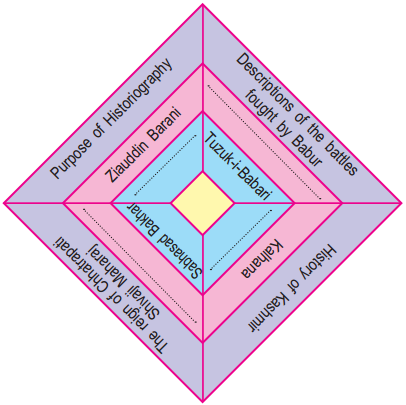
Answer: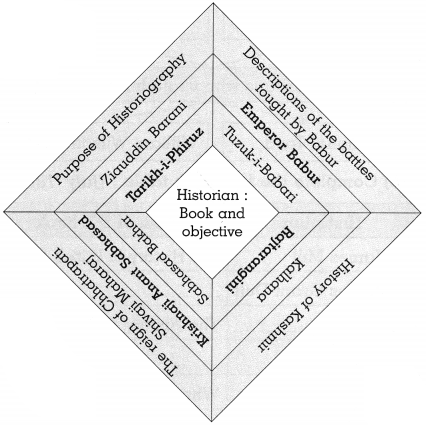
Question 5.
Explain the following concepts.
(1) Orientalist historiography.
Answer:
- In the later part of the eighteenth century many European scholars felt curious to know about civilisations and countries of the East.
- These scholars who studied the Indian Civilization had respect and admiration for it. They were known as ‘Orientalists’.
- They studied similarities between Sanskrit and some of the European languages, focussing more on Vedic traditions and Sanskrit literature.
- It resulted in the notion that an ancient language could be the mother of all Indo-European languages.
- Notable Orientalist scholars are Friedrich Max Muller and William Jones.
(2) Nationalistic historiography.
Answer:
- English education started in India in the nineteenth century. The Indian historians who were trained in English education system realised the glory of their past.
- They showed an inclination to restore the pride in the ancient glory of India and the self-esteem of the Indian readers.
- They laid the foundation of Nationalistic writing. Nationalistic writings in Maharashtra were inspired by ‘Vishnushastri Chiplunkar’.
- Nationalistic historians opposed the prejudiced history written by the British officers.
- Mahadev Govind Ranade, Vinayak Damodar Savarkar, Ramesh Chandra Majumdar are renowned Nationalistic historians.
- Nationalistic historiography inspired freedom struggle against the Britishers and gave momentum to write about regional history. While glorifying the past, at times they are blamed for ignoring to critically analyse the truth.
(3) Subaltern history.
Answer:
- History of deprived classes or communities who were deprived of all rights is known as subaltern history.
- The seeds of subaltern history can be traced in the Marxist history. Italian historian Antonio Gramsci has special importance in writing the subaltern history.
- He presented the idea that history should be written starting from the bottommost ranks of people in the society.
- Ranjit Guha, an Indian historian, has given prominence to subaltern history and played a major role in establishing it as an important academic school of historiography.
- Similar thoughts were expressed by Mahatma Phule and Dr. Babasaheb Ambedkar which can be found in their writings.
Project
Prepare an illustrated manuscript with the help of the internet giving more information about the historians mentioned in this lesson.
Answer:
Memory Map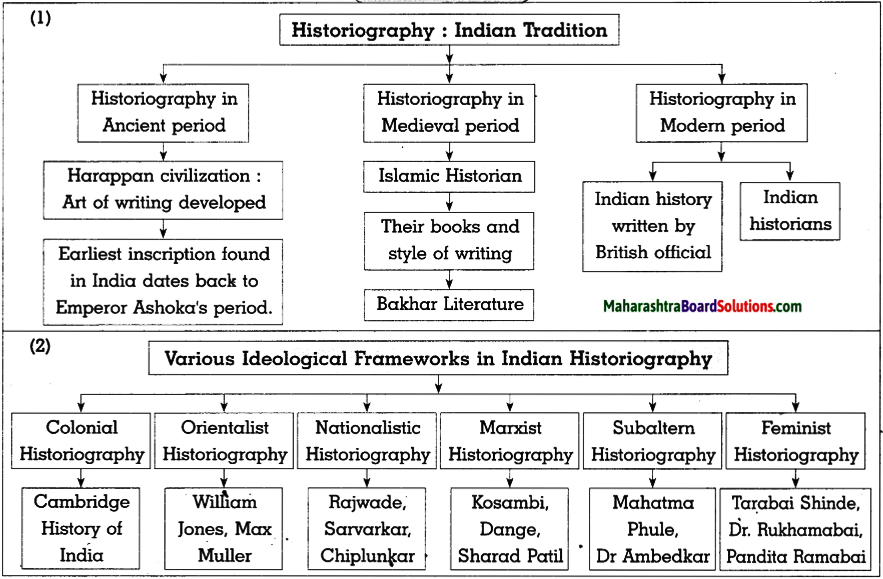
Question 6.
Complete the sentences by choosing a correct option:
(a) The first written document found in India was inscribed during the rule of Emperor ……………….. .
(a) Akbar
(b) Harshavardhan
(c) Ashoka Maurya
(d) Aurangzeb
Answer:
(c) Ashoka Maurya
(b) Banabhatta wrote King Harsha’s biography titled ………………… in the 7th century CE.
(a) Meghdoot
(b) Rajtarangini
(c) Rasratnakar
(d) Harshacharit
Answer:
(d) Harshacharit
(c) In the 12th century C.E., ………………… wrote a book ‘Rajtarangini’ about history of Kashmir.
(a) Banabhatta
(b) Kalhana
(c) Ziquddin Barani
(d) Patanjali
Answer:
(b) Kalhana.
(d) The historians in the courts of Muslim rulers were influenced by ………………… historiography.
(a) Greek and Roman
(b) Arabic and Persian
(c) English and French
(d) Arabic and Urdu
Answer:
(b) Arabic and Persian
(e) We get information about the rule of Chhatrapati Shivaji Maharaj from ……………….. .
(a) Bhausahebanchi Bakhar
(b) Panipatachi Bakhar
(c) Sabhasad Bakhar
(d) Holkaranchi Bakhar
Answer:
(c) Sabhasad Bakhar
(f) ‘Bhausahebanchi Bakhar’ describes Battle of ……………….. .
(a) Raigad
(b) Panipat
(c) Plassey
(d) Vasai
Answer:
(b) Panipat
(g) The first book written by a British historian on Indian history is ……………….. .
(a) The History of India
(b) The History of Maharaj
(c) The History of British India
(d) The Sacred Books of the East
Answer:
(c) The History of British India
(h) Nilkanth Janardan Kirtane and V.K. Rajwade exposed the limitations in writings of ……………….. .
(a) Friedrich Max Muller
(b) Colonel Todd
(c) Grant Duff
(d) William Wilson Hunter
Answer:
(c) Grant Duff
(i) …………………, an Indian historian played a major role in establishing subaltern history as an important academic school of historiography.
(a) Comrade Sharad Patil
(b) Ranjit Guha
(c) Dharmanand Kosambi
(d) Ram Sharan Sharma
Answer:
(b) Ranjit Guha.
(j) The writings of British officials on India display strong influence of ……………….. .
(a) Marxism
(b) Colonalism
(c) Feminism
(d) Capitalism
Answer:
(b) Colonalism
(k) The Nationalistic Historiography in Maharashtra was inspired by works of ……………….. .
(a) Vinayak Damotfar Savarkar
(b) Ramkrishna Gopal Bhandarkar
(c) Vishnushastri Chiplunkar
(d) Justice Mahadev Govind Ranade
Answer:
(c) Vishnushastri Chiplunkar
(l) The two volumes written by ……………….. on Indian history show impartial treatment of the subject.
(a) Colonel Todd
(b) William Wilson Hunter
(c) Grant Duff
(d) James Mill
Answer:
(b) William Wilson Hunter
(m) ‘Primitive Communism to Slavery’, represents ……………….. the historiography.
(a) Colonial
(b) Orientalist
(c) Nationalistic
(d) Marxist
Answer:
(d) Marxist
(n) ‘Stripurush Tulana’ was written by ……………….. is acknowledged as first feminist book in India.
(a) Meera Kosambi
(b) Dr. Sharmila Rege
(c) Tarabai Shinde
(d) Pandita Ramabai
Answer:
(c) Tarabai Shinde.
Question 7.
Identify the wrong pair and write it:
(1)
| Name of the Book | Types of Historiography |
| (1) Who were the | (a) Subaltern history |
| Shudras | (July ’19) |
| (2) Stripurush Tulana | (b) Feminist writing |
| (3) The Indian War of Independence | (c) Marxist History |
| (4) Grant Duff | (d) Colonial History |
Answer:
Wrong pair: The Indian War of Independence – Marxist History.
(2)
| Name of the Book | Historian |
| (1) The Rise of the Maratha Power | (a) Justice Mahadev Govind Ranade |
| (2) Marathyanchya Itihasachi Sadhane | (b) Vishnushastri Chiplunkar |
| (3) Maratha Riyasat | (c) Govind Sakharam Sardesai |
| (4) Gulamgiri | (d) Mahatma Phule |
Answer:
Wrong pair: Marathyanchya Itihasachi Sadhane- Vishnushastri Chiplunkar.
(3)
| Work | Scholars |
| (1) Bharat Itihas Samshodhak Manda | (a) V. K. Rajwade |
| (2) Asiatic Society | (b) Sir William Jones |
| (3) Inspiration for Nationalistic historiography | (c) Vishnushastri Chiplunkar |
| (4) Discovery of Harappan Civilization | (d) James Mill |
Answer:
Wrong pair: Discovery of Harappan CIvilization – James Mill.
(4)
| Historiography | Historian |
| (1) Nationalistic Historiography | (a) V. D. Savarkar |
| (2) Marxist Historiography | (b) Damodar Kosambi |
| (3) Subaltern Historiography | (c) Ramchandra Guha |
| (4) Feminist Historiography | (d) Sharmila Rege |
Answer:
Wrong pair: Subaltern Historiography – Bamchandra Guha.
Question 8.
Do as directed:
(1)
Answer: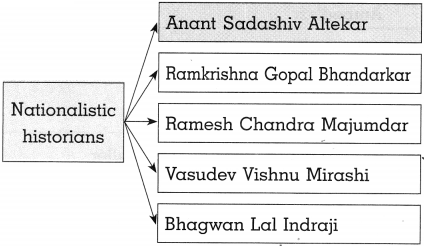
(2)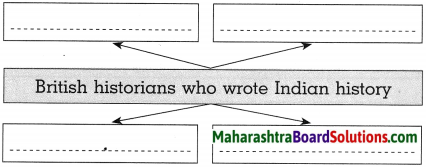
Answer:
(3) Prepare a flow chart on Literary work of Max Muller:
Answer: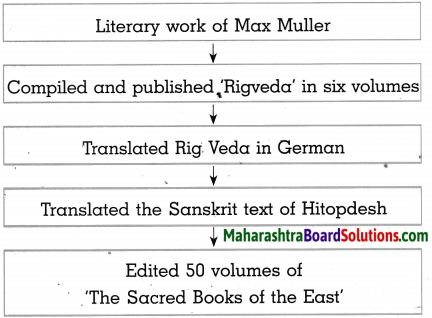
Question 9.
Explain the concepts:
(a) Colonial Historiography:
Answer:
- The history written by British officers and Christian missionaries in support of British rule and colonialism is known as Colonial historiography.
- It reflected their prejudiced mindset about Indian culture. They ridiculed the Indian culture as being primitive.
- Their writings justified the colonial British rule.
- The distinct example of colonial historiography is ‘Cambridge History of India’ in five volumes published during 1922-1937.
Question 10.
Write short notes:
(a) Alexander Cunningham:
Answer:
- British rulers started archaeological exploration and research in India in the 20th century.
- They established the Archaeological Survey of India and appointed Sir Alexander Cunningham as its first Director General.
- He mainly chose the sites mentioned in the Buddhist texts for excavations.
- Many other ancient sites were excavated under his supervision.
(b) James Mill:
Answer:
- James Mill, a‘British historian, had written the monumental book ‘The History of British India’. He published it in three volumes in 1817.
- The book is important as it was the first book written by a British officer on Indian history.
- The book: lacks objective perspective and is prejudiced about various aspects of the Indian culture.
(c) Grant Duff:
Answer:
- Grant Duff, a British officer, wrote the book ‘A History of Mahrattas’, in three volumes.
- His name stands out among the British officers who wrote about Maratha history.
- The tendency of the British historians to condemn Indian culture and history is found in Grant Duff’s writing.
- Historians Nilkanth Janardan Kirtane and Vishwanath Kashinath Rajwade exposed the limitations of Grant Duff’s writings.
(d) Indian Feminist Historiography:
Answer:
- Tarabai Shinde, Pandita Ramabai and Dr. Rukhamabai were feminist historians before independence.
- They wrote about employment of women, their right to political equality, treatment meted out to women at their workplace and gender discrimination.
- A lot of literature is available unfolding the viewpoint of Dalit women on problems like social class, caste, etc. In the post-independence era.
- Dr. Sharmila Rege included her essays on the autobiographies of Dalit women in her book, ‘Writing Caste, Writing Gender: Reading Dalit Women’s Testimonies.’
- Meera Kosambi’s book, ‘Crossing Thresholds: Feminist Essays in Social History’ contains essays on the life stories of women like Pandita Ramabai and Dr. Rukhamabai, the first practising lady Doctor of India.
Question 11.
Explain the following with reasons:
(a) The history of Indian civilization dates back to 3rd millennium BCE.
Answer:
- Indian civilisation is among the various ancient civilisations in the world.
- Excavations at Harappa took place in 1920 under the supervision of Sir John Marshall, then Director General of Archaeological Survey of India (ASI). This led to the discovery of Harappan Civilization.
- This discovery prqved helpful to trace the antiquity of Indian history which dates back 3rd millennium BCE or earlier.
(b) It became necessary to rethink of women’s position in history.
Answer:
- For a considerable period of time, mainly male scholars were involved in the writing of Indian history.
- It was obvious that the perspective was male-dominated.
- The work of the women historians was neglected for long. So it became important to highlight this fact.
- It was a huge challenge in front of the women: historians to compile the work and do research which would prove to be a medium to put forth their status in society.
Hence, it became necessary to rethink about the position of women in history.
(c) Govind Sakharam Sardesai was addressed as ‘Riyasatkar’.
Answer:
- Govind Sakharam Sardesai had a momentous achievement to his credit by publishing ‘Maratha Riyasat’.
- He published several volumes of Maratha history.
- His work became so popular that people began to address him as ‘Riyasatkar’.
Question 12.
Answer the following in 25-30 words:
(a) Which things are included in the description by Emperor Babur in bis autobiography?
Answer:
Babur, the founder of the Mughal empire, in his autobiography entitled Tuzuk-i-Babari describes:
- The battles fought by him.
- Recordings of minute observations of various regions and cities visited by him noting minute observations.
- Observation of the local customs, economy, fauna and flora of the region travelled by him.
(b) What is the contribution of Swatantryaveer Savarkar to nationalistic historiography?
Answer:
- The writings of Swatantryaveer Savarkar were infused with nationalistic ideas. He looked at the revolt of 1857 as the First War of Independence and wrote the ‘book ‘The Indian War of Independence, 1857’.
- His book gave inspiration to Nationalistic historiography which helped in triggering independence movement of the Indian people against the British. Even the writing of regional history got momentum.
- The attention of historians was drawn towards the history and geographic conditions and variations in the South Indian region.
(c) Write about the contribution of Banabhatta in writing historiographies.
Answer:
- It was considered an important step in the Indian historiography to write biographies of kings and dynastic histories.
- Banabhatta wrote Harshacharit, King Harsha’s biography, in the 7th century C.E.
- It portrays a realistic picture of the social, economic, political, religious and cultural life during the period when King Harsha ruled.
(d) Write information on ‘Rajtarangini’.
Answer:
- Rajtarangini was written by Kalhana in the 12th century C.E. It traces the history of Kashmir.
- These eight books contain records of dynasties which ruled Kashmir, local traditions, coins, remains of monuments and inscriptions. Kalhana wrote the text after critically examining the various sources.
- The book is a good example to show how scientific technique is applied in writing history.
(e) Write about historiography in the post-independence period.
Answer:
- In the post-independence period, along with dynastic history, cultural, social and economic histories were also written.
- New schools of thought like Marxist, Subaltern and Feminist History were included in historiography.
- The scholars in this era began to feel the need of writing histories of various communities, sciences, economic systems, political ideologies, cultural aspects, etc.
- They presented the new schools of ideologies. These changes increased the scope of writing historiography.
(f) What are the objectives of writing history according to Ziauddin Barani?
Answer:
- Ziauddin Barani explained the ’ objectives of historiography. According to him, the duty of a historian does not end with recording the ruler’s valour and welfare policies.
- He should also write about the ruler’s failings and incorrect policies.
- He further adds that a historian should also take into account the impact of the teachings of the wise, the learned and the saints on the cultural life of people.
Thus, Ziauddin Barani holds important place as he expanded the scope of historiography.
(g) What are the salient features of writings of historians in the courts of Mughal emperors?
Answer:
The salient features of writings of historians in the courts of Mughal emperors are:
- Historians praised the Mughal emperors in their writings.
- Their loyalty towards the rulers is exhibited.
- The custom of adding suitable poetic quotes was introduced. The historians started to include beautiful pictures as well.
(h) Write about the importance of Tarabai Shinde in writing feminist historiography. *
Answer:
- Tarabai Shinde has a prominent place among the feminist historians who wrote about women in the nineteenth century, i.e. pre-independence era.
- She wrote a book Stripurush Tulana which was published in 1882. It is acknowledged as the first feminist book published in India.
- Her writings attacked the male-dominated social system and the caste system.
Question 13.
Read the given passage and answer the questions given below:
(a) Complete the graphical presentation:
Answer:
(b) What was considered more important by the historians in the Mughal Court?
Answer:
Praising the Mughal emperor and exhibition of loyalty was considered more 8 important by the historians in the Mughal Court.
(c) Why is Abbul Fazl’s writing considered realistic?
Answer:
- Abul Fazl’s Akbarnama reflects his critical viewpoint.
- He collected authentic historical documents for this book.
- He scrutinized these documents to affirm their reliability. Therefore, his method is looked upon as devoid of bias and hence realistic.
Question 14.
Write detailed answers to the following questions:
(a) Write information about historiography in the ancient period of India.
Answer:
- In the ancient period, stories of great deeds of ancestors, mythological lore, memories of social transitions were preserved through oral traditions.
- The art of writing was mastered by Indians as early as 3rd millennium B.C.E. But Harappan script is not deciphered yet.
- The earliest written documents found in India were in the form of inscriptions that are as old as 3rd century B.C.E. during the period of Emperor Ashok. His edicts are inscribed on natural rocks and stone pillars.
- Inscriptions started to occur on coins, metal images and sculptures and also on copper plates from the 1st century B.C.E.
- Epics like Ramayana, Mahabharat, Puranas, Jain and Buddhist texts are important sources of ancient Indian literature.
- Historical accounts by Indian authors and travelogues by foreign travellers are also important sources of history.
(b) Explain the works of Dr. Babasaheb Ambedkar and Mahatma Phule in Subaltern History.
Answer:
- History of the deprived classes expressed in folklore was known as ‘Subaltern History’.
- Similar thoughts were expressed by Mahatma Jotirao Phule and Dr. Babasaheb Ambedkar.
- Mahatma Phule unfolded the history of the Shudratishudra communities in his book ‘Gulamgiri’.
- He drew attention to show how women, Shudras and Atishudras were exploited under the name of religion.
- Dr. Ambedkar focused on the idea that in spite of having a significant role in shaping the cultural and political aspects of India, the role of Dalits was not duly acknowledged in colonial and nationalistic historiography.
- Injustice done to the Dalits was mostly written by him. ‘Who Were the Shudras’ and ‘The Untouchables’ are his books which can be cited as examples of subaltern history.
Question 15.
Observe the given picture and answer the question given below:
(a) Write a short note on Copper-plate inscriptions.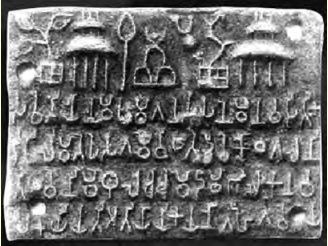
Answer:
- The copper-plate shown in the picture was found at Sohagaura in Gorakhpur district in Uttar Pradesh.
- It is supposed to be from the Mauryan period and the inscription on it is in Brahmi script.
- Many symbols are inscribed on it ‘Tree-in-railing’ and ‘Mountain’ at the beginning of inscription occur on punch marked coins.
- A structure created on four pillars is indicative of a granary.
- The inscriptions have a record of royal order that the grains stored in the granary should be distributed carefully.
- This order is suggestive of precautionary measures taken during famine.
इयत्ता दहावी इतिहास स्वाध्याय उपाय
- इयत्ता दहावी इतिहास धडा पश्चिमेतील इतिहासलेखन विकास मराठी स्वाध्याय PDF
- इयत्ता दहावी इतिहास धडा इतिहासलेखन भारतीय परंपरा मराठी स्वाध्याय PDF
- इयत्ता दहावी इतिहास धडा उपयोजित इतिहास मराठी स्वाध्याय PDF
- इयत्ता दहावी इतिहास धडा भारतीय कलांचा इतिहास मराठी स्वाध्याय PDF
- इयत्ता दहावी इतिहास धडा मास मीडिया आणि इतिहास मराठी स्वाध्याय PDF
- इयत्ता दहावी इतिहास धडा मनोरंजन आणि इतिहास मराठी स्वाध्याय PDF
- इयत्ता दहावी इतिहास धडा क्रीडा आणि इतिहास मराठी स्वाध्याय PDF
- इयत्ता दहावी इतिहास धडा पर्यटन आणि इतिहास मराठी स्वाध्याय PDF
- इयत्ता दहावी इतिहास धडा हेरिटेज व्यवस्थापन मराठी स्वाध्याय PDF






0 Comments:
Post a Comment